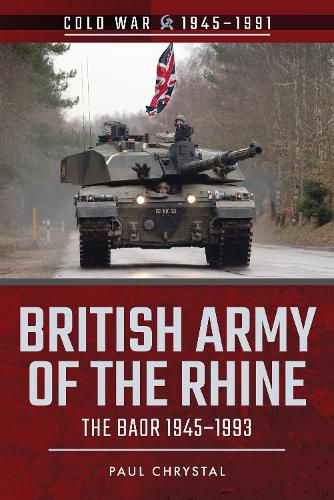Readings Newsletter
Become a Readings Member to make your shopping experience even easier.
Sign in or sign up for free!
You’re not far away from qualifying for FREE standard shipping within Australia
You’ve qualified for FREE standard shipping within Australia
The cart is loading…






The nervous geopolitical tension between East and West, the Cold War, emerged before the end of the Second World War and lasted until 1991 with the collapse of the Soviet Union. The British Army of the Rhine was born in 1945 out of the British Liberation Army at the close of the war as the military government of the British zone of occupied Germany. As the Soviet threat increased, so BAOR became less of an occupational army and assumed the role of defender of Western Europe, and as a major contributor to NATO after 1949. This book traces and examines the changing role of BAOR from 1945 to its demise in the 1993 Options for Change defence cuts. It looks at the part it played in the defence of West Germany, its effectiveness as a Cold War deterrent, the garrisons and capabilities, logistics and infrastructure, its arms and armour, the nuclear option and the lives of the thousands of families living on the front line. AUTHOR: Paul Chrystal is the author of some seventy books published over the last decade, including publications on Leeds’s architecture and history, and on conflict and warfare: Leeds in 50 Buildings (2015), Central Leeds Through Time (2016), Wars and Battles of the Roman Republic (2014), Roman Military Disasters (2015) and Women and War in Ancient Greece and Rome (forthcoming 2017). He is a regular contributor to history magazines, local and national newspapers and has appeared on BBC Radio 4, BBC World Service and on BBC local radio throughout Yorkshire, and in Teesside and Manchester. 20 colour and 80 b/w images
$9.00 standard shipping within Australia
FREE standard shipping within Australia for orders over $100.00
Express & International shipping calculated at checkout
The nervous geopolitical tension between East and West, the Cold War, emerged before the end of the Second World War and lasted until 1991 with the collapse of the Soviet Union. The British Army of the Rhine was born in 1945 out of the British Liberation Army at the close of the war as the military government of the British zone of occupied Germany. As the Soviet threat increased, so BAOR became less of an occupational army and assumed the role of defender of Western Europe, and as a major contributor to NATO after 1949. This book traces and examines the changing role of BAOR from 1945 to its demise in the 1993 Options for Change defence cuts. It looks at the part it played in the defence of West Germany, its effectiveness as a Cold War deterrent, the garrisons and capabilities, logistics and infrastructure, its arms and armour, the nuclear option and the lives of the thousands of families living on the front line. AUTHOR: Paul Chrystal is the author of some seventy books published over the last decade, including publications on Leeds’s architecture and history, and on conflict and warfare: Leeds in 50 Buildings (2015), Central Leeds Through Time (2016), Wars and Battles of the Roman Republic (2014), Roman Military Disasters (2015) and Women and War in Ancient Greece and Rome (forthcoming 2017). He is a regular contributor to history magazines, local and national newspapers and has appeared on BBC Radio 4, BBC World Service and on BBC local radio throughout Yorkshire, and in Teesside and Manchester. 20 colour and 80 b/w images